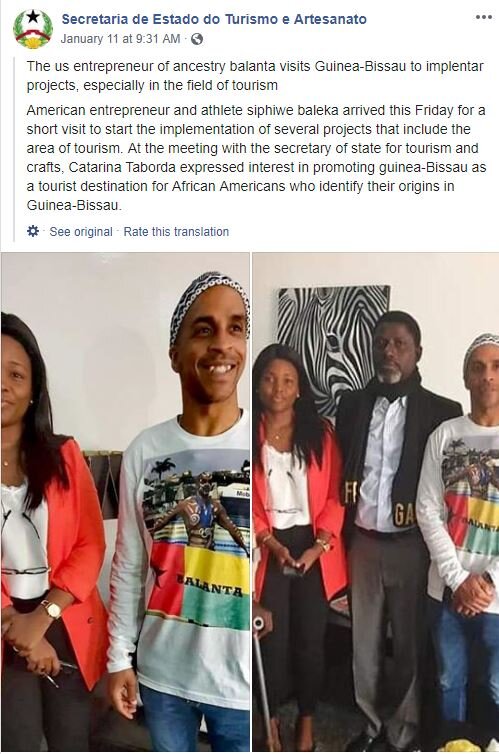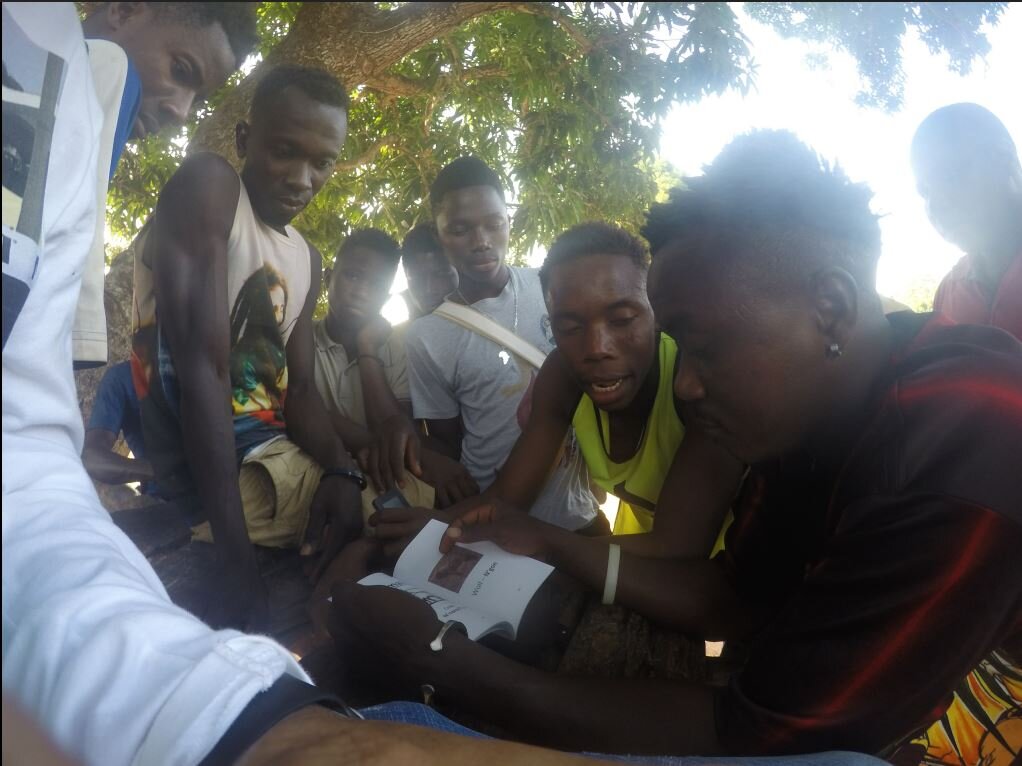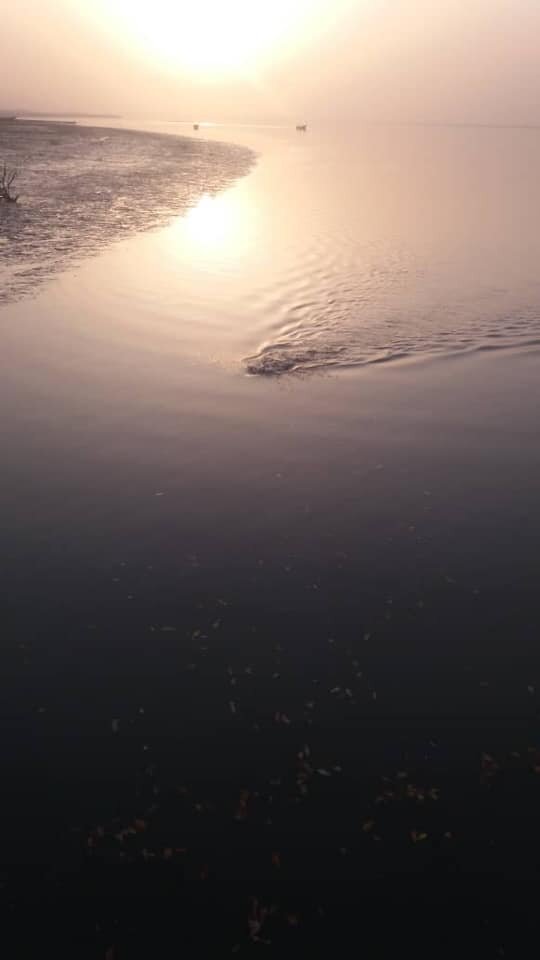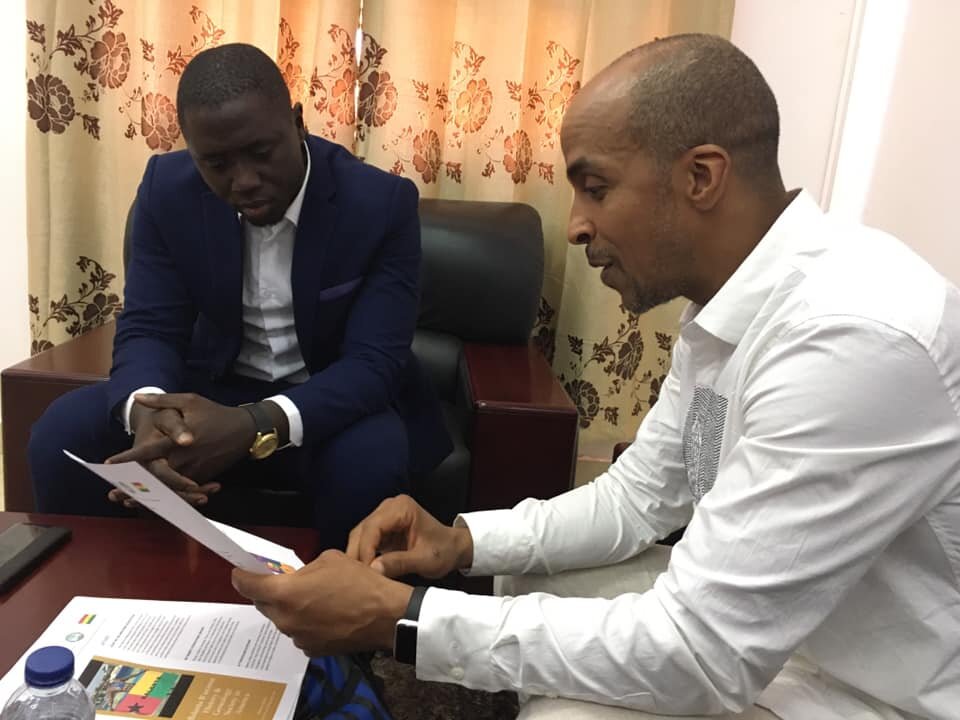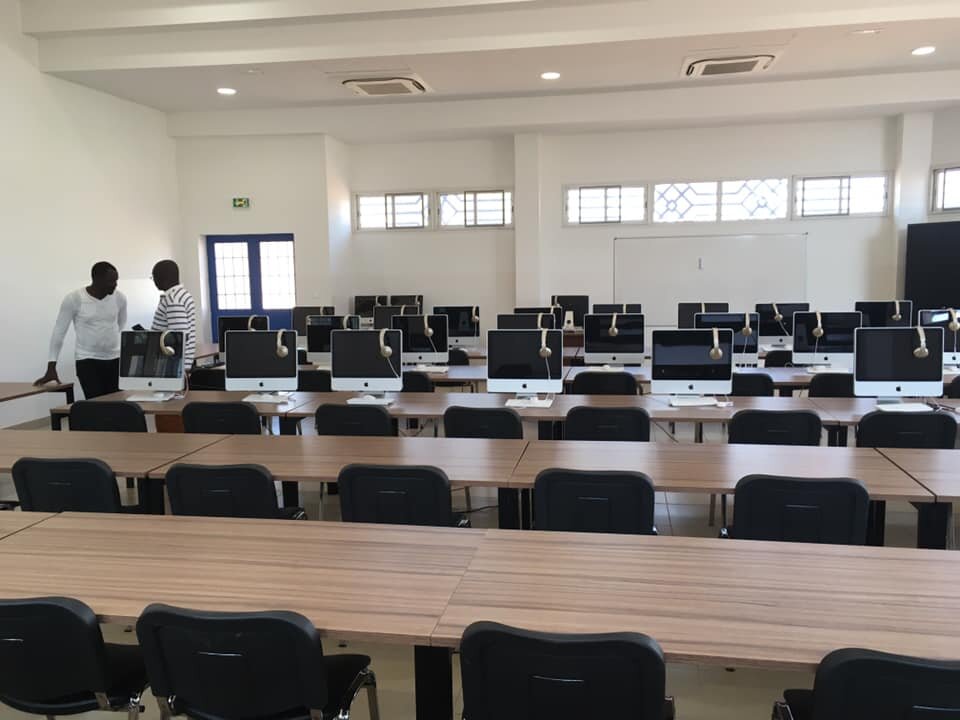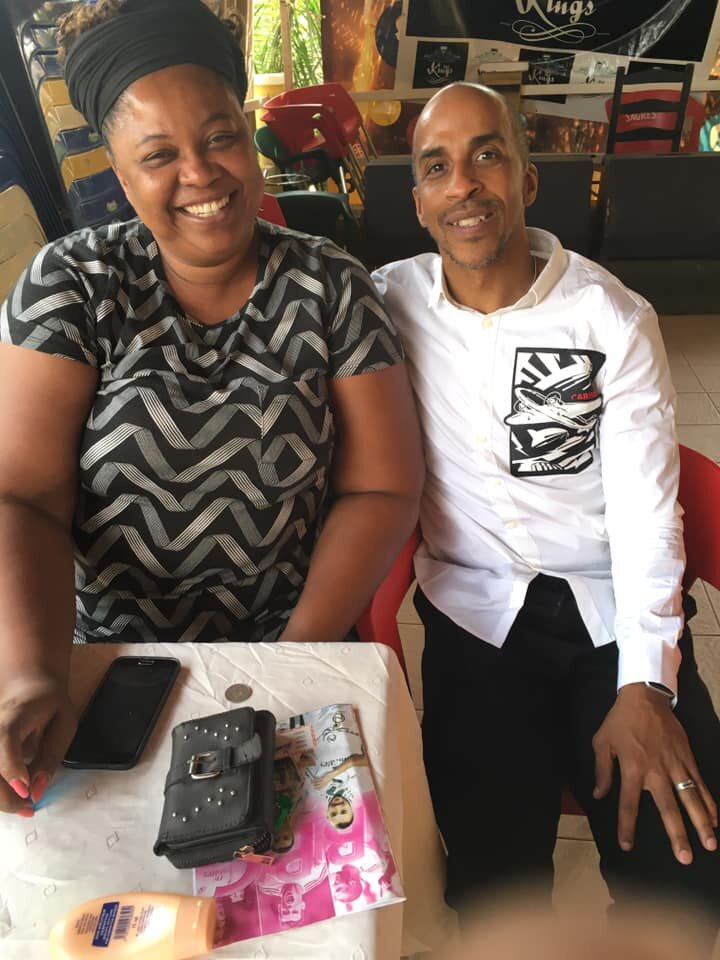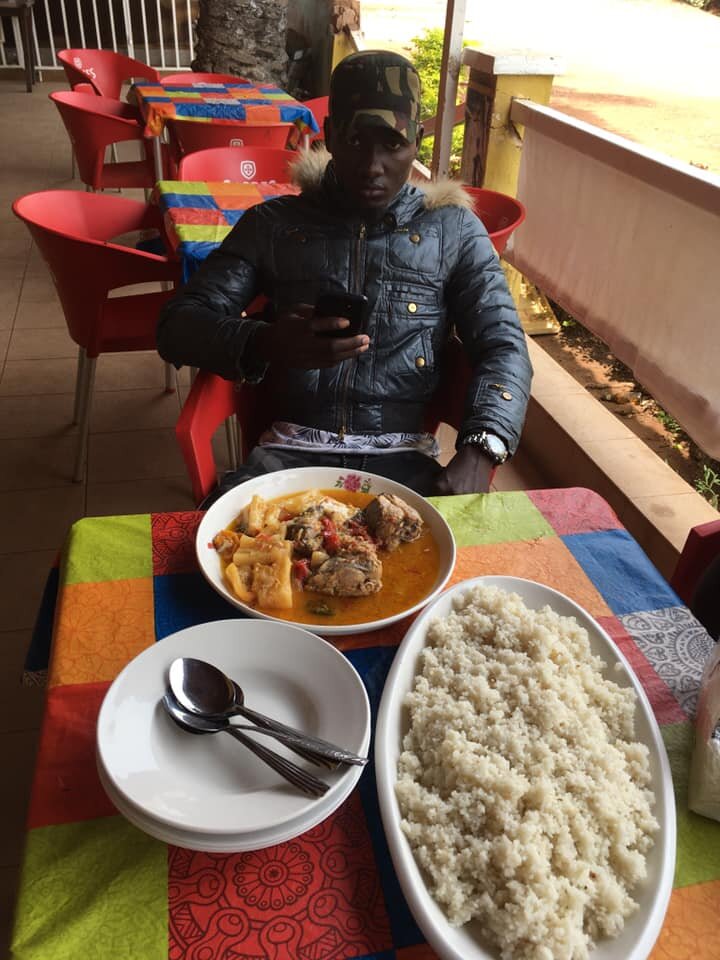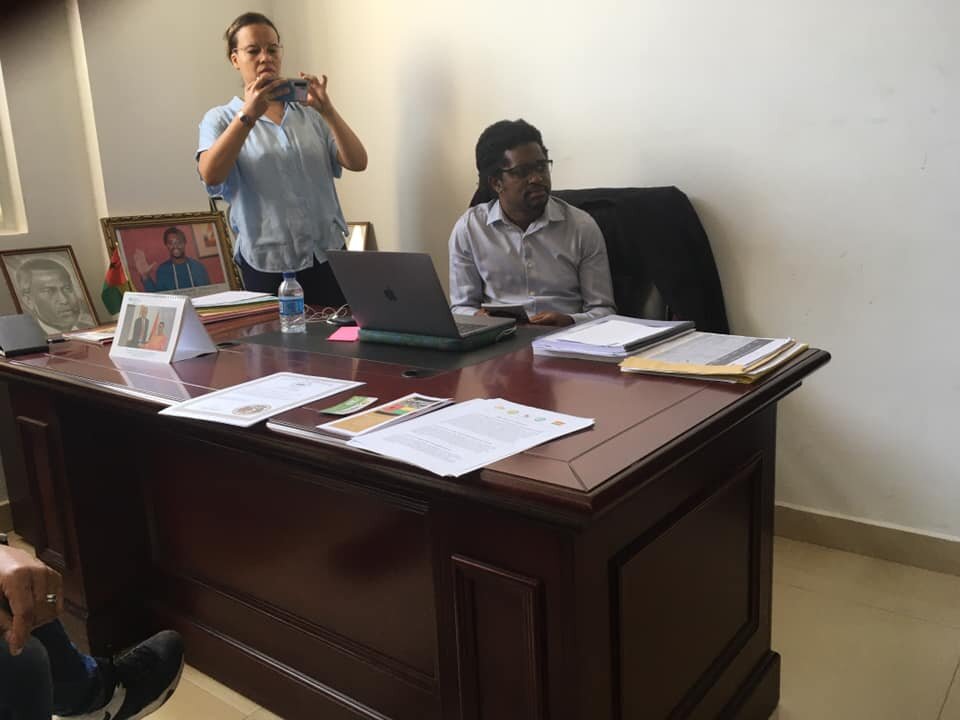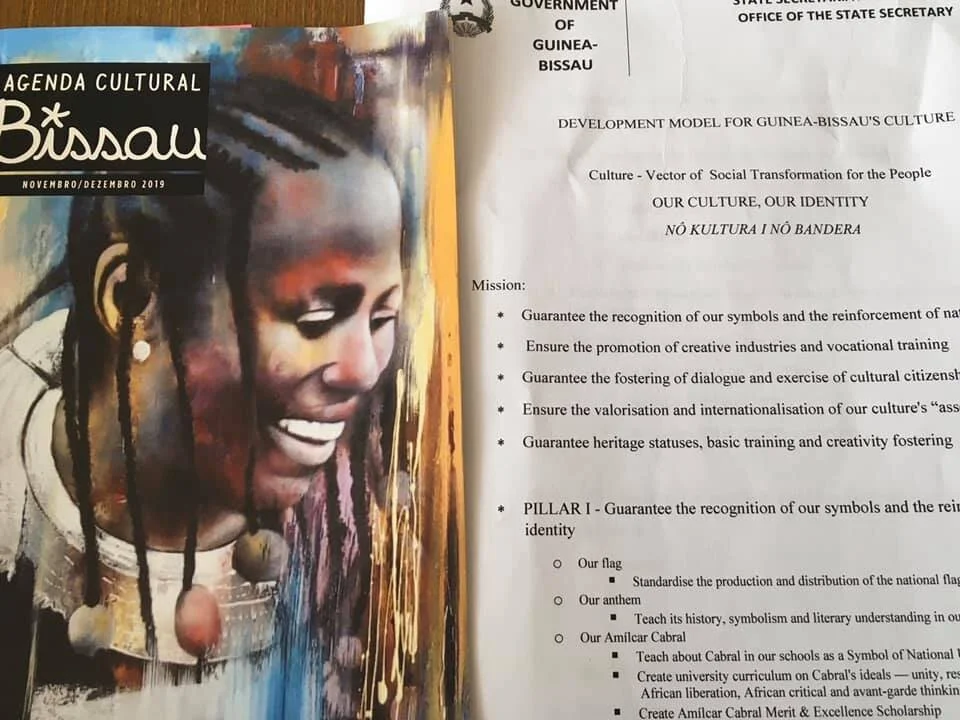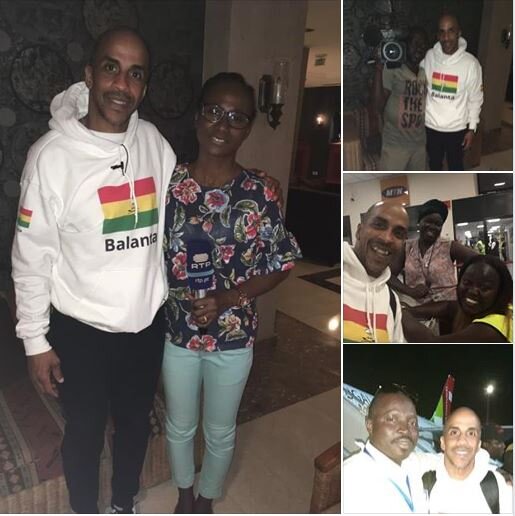“Our ancestors saw in a vision that one day this thing will happen. This is an open door that people will come. And when the Balanta come there has a people that will take them saying, ‘this is your people’.” - Alante Ndang Elder to Brassa Mada (Siphiwe Baleka) at the Bam’fada Council in Bairro, Militar, January 15, 2020
The following is my report, as President of the Balanta B’urassa History and Genealogy Society in America, detailing the historic events of my visit to Guinea Bissau from January 10th to the 17th, 2020.
Before I even left for Guinea Bissau, the country was preparing for my visit. It was reported in RPT Noticias and several Guinea Bissau blogs.
I departed from Springfield, MO at about 11:30 am and flew to Denver, then to London, then to Lisbon and finally to Bissau. In total, the trip took 33 hours with a few hour layover in each city. I didn’t sleep much so I was exhausted when I arrived at about 1:30 am Friday morning, January 10th. My host, translator and Balanta brother Mario Ceesay explained to me that before we could leave the airport, the Alante Ndang (initiated elder) needed to ask the ancestors to bless my journey and make it successful. I was presented with the traditional Pano di pinte (painted cloth) and a bushel of rice symbolizing prosperity.
The following morning at the Hotel Imperio, there was a press conference where I met with the Minister of Tourism, Catarina Taborda, and explained to her a plan to launch Guinea Bissau’s “Decade of Return” Initiative.
Development Program for Ministry of Tourism
1. WE ARE UNITING THE PEOPLE OF BALANTA DESCENT IN THE WESTERN HEMISPHERE
From 1668 to 1829, 145,000 people were shipped from the slave trading port at St. Louis, Senegal. From 1668 to 1843, 126,000 people were shipped from the slave trading port of Bissau on the coast of modern-day Guinea Bissau, West Africa. These are the lands were Balanta people were living. From these two slave trading ports, 6,400 people were brought to the Gulf Coast, 10,000 people were brought to the port at Charleston, South Carolina, 4,500 people were brought to Chesapeake, and 1,400 people were brought to New York. Based on records from slave voyages and the 2,054 voyages that departed from the three rivers area of the Balanta homelands in Guinea Bissau, BBHAGSIA estimates that 10,000 Balanta have been identified by the African Ancestry test and that there are a minimum of 30,000 Balanta descendants in the United States of America. In addition, 85,800 people were brought to the Islands of the West Indies and even more to Brazil. With the success of our efforts in the United States, we will help the descendants of Balanta in those areas as well.
2. WE ARE SETTING AN EXAMPLE FOR THE TWENTY OTHER ETHINC GROUPS
If you include Baga, Banhun, Biafada, Bijago, Bissau, Cacheu, Cassanga, Floup, Jola, Manjaco, Nalu, Papel, Sape, Bambara, Fula, Gabu, Geba, Jalonke, Mandika and Mouro, it is estimated that there are as much as 500,000 people who are descendants of people taken from the ports of Ziguinchor, Cacheu, Bissau, Geba, St. Louis (Senegal). There are even more such people in the Caribbean Islands and in Brazil. We will show them how we organized ourselves and create a Descendants of the People of Guinea Bissau Council to serve as a coordinating body to work with the Guinea Bissau Ministry of Tourism.
3. WE HAVE A PLAN FOR GUINEA BISSAU “YEAR/DECADE OF RETURN”
Countries such as Ghana, Sierra Leone, Nigeria, Gabon and Benin are receiving a tremendous amount of positive international publicity for their “Year of Return” initiatives. These countries are embracing their lost ancestors, sons and daughters and providing culture and heritage opportunities. In some cases, passports and citizenship are being offered. Ghana has seen tourism increase by 25% and has generated hundreds of millions of dollars. We believe that Guinea Bissau can benefit as well.
4. HUMAN CENTERD FOCUS
Guinea Bissau can set an example for the rest of Africa by focusing on human development first from which economic development will follow as a natural by-product. Since the earliest repatriation programs in 1796 to Sierra Leone until today, the focus has always been on the economic benefits and the possibility for “civilizing” and “Christianizing” Africa. Media reports about the Year of Return focus on the potential revenue from cultural/heritage tourism as well business investment. Very little concern is shown for the actual people who are returning who have suffered the effects of the trans-Atlantic trafficking of African people and their enslavement for as much as seven generations. Due to the recent advent of genetic testing, people are discovering their ancestral identity that was taken from them. As a result, people know exactly where in Africa they came from and the people they descend from. Guinea Bissau can encourage such people to come and reconnect with their ancestral communities – Balanta with Balanta, Djola with Djola, Fula with Fula, etc. When these connections are made, the bonds restored, and the spiritual and social “repairing” of the people and the communities happen, then people-centered development will lead to economic development that is supported by the communities themselves. In this way, the returnees become part of the local communities and not a separate community amongst themselves which could lead to misunderstandings and conflicts.
5. Unity for Guinea Bissau People
It will be important for the people of Guinea Bissau to understand and be sensitive to the fact that for people who are discovering who their ancestors are after several generations, there is a profound sense of fulfillment. This expresses itself as pride in one’s ancestors and ethnicity. The people of Guinea Bissau will need to understand that such expressions of ethnic pride is in no way a form of tribalism or xenophobia. For our part, we must understand that Amilcar Cabral required that all ethnic groups become one people for the sake of Guinea Bissau. We aim to show this by forming a Descendants of the People of Guinea Bissau Council that will include Balanta, Nalu, Bijago, Fula, Mandinka, etc. – all the ethnic groups of Guinea Bissau, and plan our travel tours together, so that we arrive in Guinea Bissau as one people before we go and visit our ethnic communities.
6. GUINEA BISSAU MARKETING ADVANTAGE
Ghana has successfully marketed its “Door of No Return” as the symbol and location of the trans-Atlantic slave trade. However, if one wants to return to where the trans-Atlantic slave trade began and learn the origin, then one must come to Guinea Bissau. In addition, unlike some countries that received their independence from their colonial masters as a “grant”, the people of Guinea Bissau fought and won a war of liberation. Therefore, ALL people of African descent will desire to come to Guinea Bissau.
VISIT TO TCHOKMON
We drove a few hours north of Bissau between Nhacra and Bissora to a Balanta Village called Tchokman. Mario explained to me that this village supplied many of the Balanta fighters during their liberation war against the Portuguese. After the war, for various reasons, the village, and many other Balanta villages, where left out of development programs. Because Balanta people did not desire to “integrate” with the outside world, they didn’t develop such contacts, and many students, unable to go to high school or college, discontinued their education. Going to school abroad just wasn’t an option.
Upon my arrival, we explored a little and visited one household with a small cassava farm. Then we sat under a big tree and awaited for the village meeting to start and I just watched all the comings and goings in the village. I pulled out on of Sansou Tchimna’s Balanta B’rassa Basic Word List books and started counting in B’rassa and this broke the ice. Next thing I know, the older boys seized the book and started studying it all together! It was an amazing moment to see how eager they were to read and pronounce every single word.
Eventually, the meeting started. An Alante Ndang Elder that accompanied me and Mario explained to the village meeting who I was and my purpose for visiting. I explained to them how Balanta people were captured in the slave trade and that now we are coming back. They explained to me about life in the village. I asked them what are the priority needs and a male elder and a female elder both described the situation with the well. The women spend all day going to and from doing work, often carrying baskets on their heads. They are tired. When they need water for cooking or cleaning, they most go to the well and pull a bucket 30 meters! They would like to get solar panels, attach them to a pump and taps, so that they can get water easily. They also described the situation when a person in the village becomes ill. There is no health clinic in the area so the residents must bring the sick person to the nearest town which is about a 30 minute bicycle ride. Often, the sick person is not able to be transported on the back of a bicycle and sometimes they might have to wait for transportation. In the meantime, the sickness gets worse while simply waiting. So they would also like a basic health clinic in the village.
One of the things that struck me was how the boys that are my sons age were responsible for the cattle. In the early evening they entered the village together with the cattle and I thought to myself, “wow, they have a job, they have responsibility, they have the freedom to move around the village. I don’t let my sons go out of the yard and they stay inside most of the day watching videos and playing video games!” The whole village was functioning in groups - young boys over here, young girls over there, old men doing this, women doing that…. While there was activity everywhere, there was peace and harmony. This was the exact opposite of the “security situation” that the international community was always reporting about and for which the United States has issued a travel advisory warning Americans not to go to Guinea Bissau. Nothing could be further from the truth. I could see how colorless (white) Americans might be afraid, but if you are black, there is nothing to fear at all. I have been to seven countries in Africa and a total of 40 countries all over the world and the people of Guinea Bissau are the most loving and welcoming people I have ever met!
VISIT TO CACHEU
The next day we drove a few hours to Cacheu, one of the earliest European colonial settlements in sub-Saharan Africa, due to its strategic location on the Cacheu river. The name is of Bainuk origin: "i.e. Caticheu, meaning 'the place where we rest'." The Portuguese built a fort there in the 16th century. In September of 2016, the Memoria da Escratura (Slave Memorial) Museum was opened. From 1668 to 1843, 126,000 people were shipped from the slave trading port of Cacheu, many of them Balanta. This is the most likely place that my great, great, great, great, great grandfather last saw his homeland. In the future, I hope to be able to determine the ship that he was carried on, and help others determine the same. I discussed this and research opportunities for members of the Balanta B’urassa History & Genealogy Society in America with the Mayor of Cacheu, it’s Parliamentary Representative, and the Slave Museum Director, who accompanied me while exploring the Museum and Fort. The local newspaper and radio also did an interview.
I had to take a private moment and try to wrap my brain around the fact that my great, great, great, great, great grandfather was just a boy when they chained him and put him on the ship. What was he thinking as the boat left the harbor?What kind of horror was he filled with. I broke out in tears. It was a painful moment.
Concluding that his last thought was to jump out of the boat and swim back to his home, I honored him be swimming from west to eat in the river. Then, I swam from east to west in the river to symbolize returning to America to get my family like Harriet Tubman..
The Slave Fort at Cacheu
The place where the slaves were held
Swimming back to my Balanta homeland
May my great, great, great, great, great grandfather rest in peace!
Strangely, and thankfully, during the entire time while I was exploring the slave fort, I heard drumming in the distance. I followed the call of the drum. I needed it. I was feeling sad, but the drums were making me feel better. Click here to see what I found.
MINISTER OF SPORT
In the morning, I went to the Palacio do Governo in my capacity as the African Sports Ventures Group (ASVG) North America Regional Director to meet with the Guinea Bissau Minister of Sport Mr. Dionisio Pereira to discuss ASVG’s program to bring African American professional athletes to their ancestral homelands during the “Decade of Return”. The Minister agreed to write a letter of special invitation to a legendary multiple Olympic champion who happens to have Balanta ancestry to join our group during our Africa Day 2020 Tour to Senegal and Guinea Bissau. Once I receive the invitation letter, deliver it to the athlete, and confirm acceptance, I will announce who it is. I can’t wait.
After that meeting, I had the opportunity to go to teach the Research Methodology class at the Universidade Lusofona de Guine and meet with the University President to discuss teaching opportunities at the university. It was a remarkable moment. The students were amazing!
NETOS DE BANDIM
After all the meetings, we made our way to Netos De Bandim. I was told that a cultural group wanted to welcome me. I had no idea what would come next.
Escola Nacional de Administration (ENA)
The next morning we headed to the Escola Nacional de Administration (ENA) which is like a business school. Their mission is to train professional administrators who are not politicians to run the country in a professional manor. The school Director, Braima Sanha, a man of outstanding vision and talent, taught me about the school’s history and struggle. Various governments in Guinea Bissau history have not supported the school. Strangely, they have a wonderful modern facility with computer equipment that has great capacity but is under utilized. At the moment, they have computers but inadequate internet capability, so they need high powered routers. They are sending me a detailed list of equipment needs.
National Research Institute (INEP)
After meeting with the Escola Nacional de Administracao (ENA) we headed to the National Research Institute (INEP) to meet with INEP Director Joa Paulo, and Dr. Raul Fernandez, Vice-Director da Universidade Amilcar Cabral to discuss the project to translate all three volumes of my history of the Balanta called Balanta B’urassa, My Sons: Those Who Resist Remain. We also discussed the future research agenda for the study of the descendants of the people of Guinea Bissau who were captured and enslaved across the Atlantic. I handed Dr. Paulo an official copy of my Balanta ancestry documentation from African Ancestry.
The visit with INEP culminated with a meeting with Dr. Fode Mane, Director da Universidade Amilcar Cabral. I was honored with an Amilcar Cabral scarf.
To celebrate we went to eat at Mama Lu’s (that’s what I call her). The food is delicious.
Jardim Infantil Nhima Sanha School
Across the street from Mama Lu’s restaurant is the Jardim Infantil Nhima Sanha school. It has just 8 classrooms for three hundred children and no modern plumbing so they are constantly cleaning the bathroom. The teachers and staff and kids are amazing. Funding from donor agencies in America has been ongoing for five years but none of it has reached the school....
Bam’Fada
That night, a group of Balanta lawyers and judges on the High Court came to strategize on national Balanta development. I explained to them our vision of human-centered development based on ancestry and we all agreed that their existing organization work to unite all Balanta in the north, south, east and west under the name Bam’Fada which means “Children of the same father”.
The next morning, we headed over to Bombolom Radio to talk to the people of Guinea Bissau
MINISTER OF CULTURE
After Radio Bombolom, we met with Secretaria de Estado da Culture (Minister of Culture) Dr. Antonio Spencer Embalo to discuss our upcoming Africa Day 2020 Tour to Senegal and Guinea Bissau May 25 - June 2 and the country’s plans to receive us and launch Guinea Bissau’s Decade of Return initiative. The focus is on human connection and using ancestry and culture as the basis of creating strong bonds among people as a prerequisite for successful long-term development that prioritizes communities that lack access to traditional modern institutional resources. Specific details of working relationships and projects were agreed to, especially concerning language preservation. They are very excited about what the Balanta community is doing and hopes that all the ethnic groups can follow this model and work together.
Immediately after the meeting with the Secretary of Culture, we interviewed with Fatima Tchuma Camara of Sindicato National Dos Jornalistas e Tecnicis da Comunicado Social SINJOTECS
Balante Ndang Council in Bairro Militar, Bissau
The big moment when the B’alante N’dang (big men who have been through the Fanado initiation) of the north, south, east and west gathered together for me to stand before them. This was the first time the full council has gathered like this to receive someone. The occasion was historic and momentous. For the better part of two hours I had to literally stand while addressing them. I thanked the ancestors. I told them my family history. I told them about the ancient history of the Balanta ancestors. I told them the work we are doing to organize Balanta in America. The members of the Bam’fada (the Balanta administrators for our development initiative) explained our plans and how we have worked out logistics). The council has given us their unanimous support and agreed this is a historic moment and new chapter in Binham Brassa history.
“Our ancestors saw in a vision that one day this thing will happen. This is an open door that people will come. And when the Balanta come there has a people that will take them saying, ‘this is your people’.” - Alante Ndang Elder to Brassa Mada (Siphiwe Baleka) at the Bam’fada Council in Bairro, Militar, January 15, 2020
I also managed a lunch with E. Rose Custis, Cultural Affairs Officer at the Embassy of the United States of America for Senegal and Guinea Bissau, and breakfast with Nancy Robinson, Senior Political Affairs Officer, United Nations Integrated Peacebuilding Office in Guinea Bissau.
On the last day, we started the morning with an interview Carlos Amadou Balde for O Golo GB. They have been supporting me ever since I competed in the 1st Masters Swimming International Championships in Cairo, Egypt last October. In the interview, I leaked information about my opportunity to swim in this summer’s Olympics representing Guinea Bissau. You can watch the interview here.
Sapo Desporto also reported on my visit in their media:
The day and the entire tour was exhausting, but I was blessed to have the legendary Balanta revolutionary musician, Domingos Broksa, come to the hotel and soothe my soul with his music, composing a song to document my visit.
The day and the tour was not yet over. I had one more live interview on the national tv station TGB Televisão da Guiné-Bissau and following that a final interview for RTP - Rádio e Televisão de Portugal Africa. Only then did I head to the airport to return to the United States.
Now that I have returned, I am working on all the follow-up and preparing a completed Development Agenda for 2020 including specific fundraising platforms for each project. We are still $300 short of the $1500 for our first project, so please donate so we can finish what we started.
Overall, the mission was a tremendous success and Guinea Bissau - its people and institutions, are all preparing the homecoming scheduled for May 31- to June 2. If you would like to join us for our Africa Day 2020 Tour to Senegal and Guinea Bissau, please click the link and register. This is going to be an amazing event to launch Guinea Bissau’s Decade of Return.


